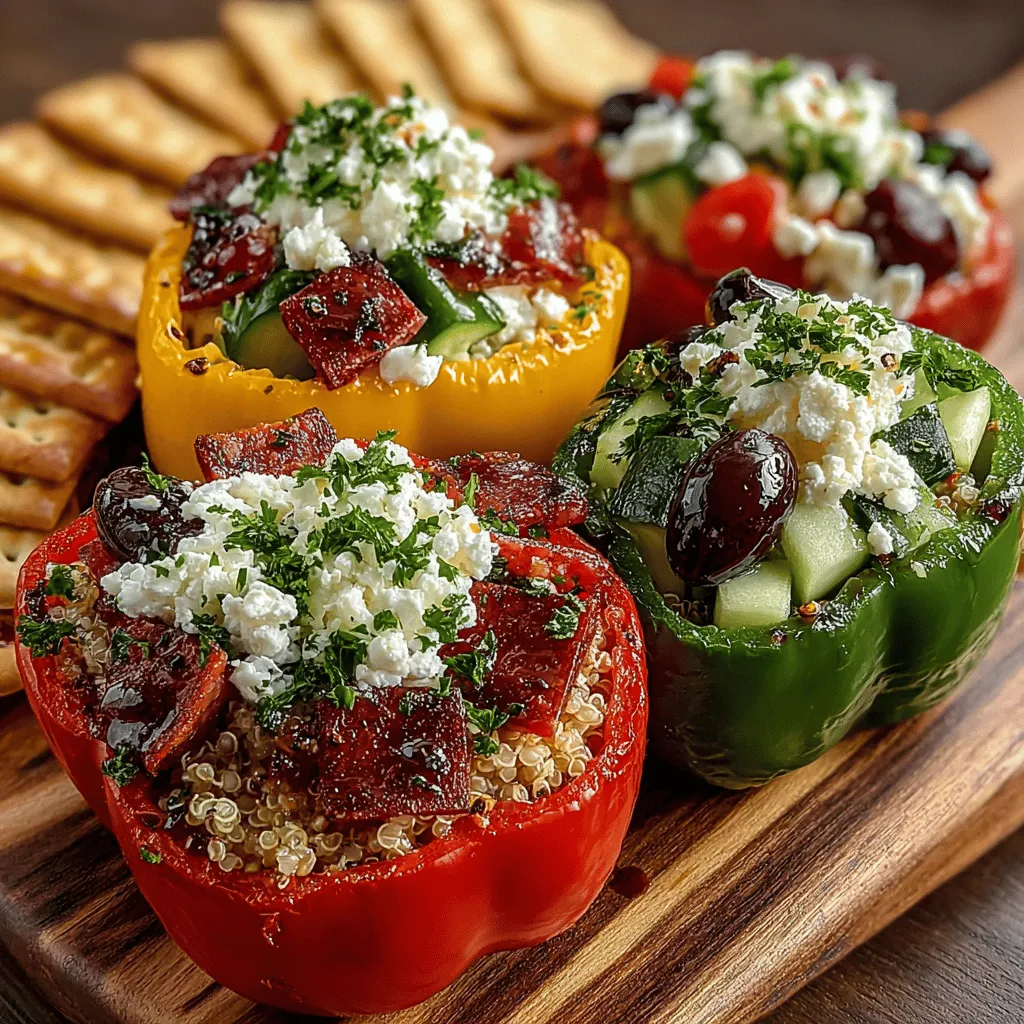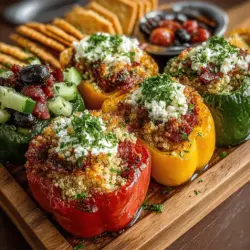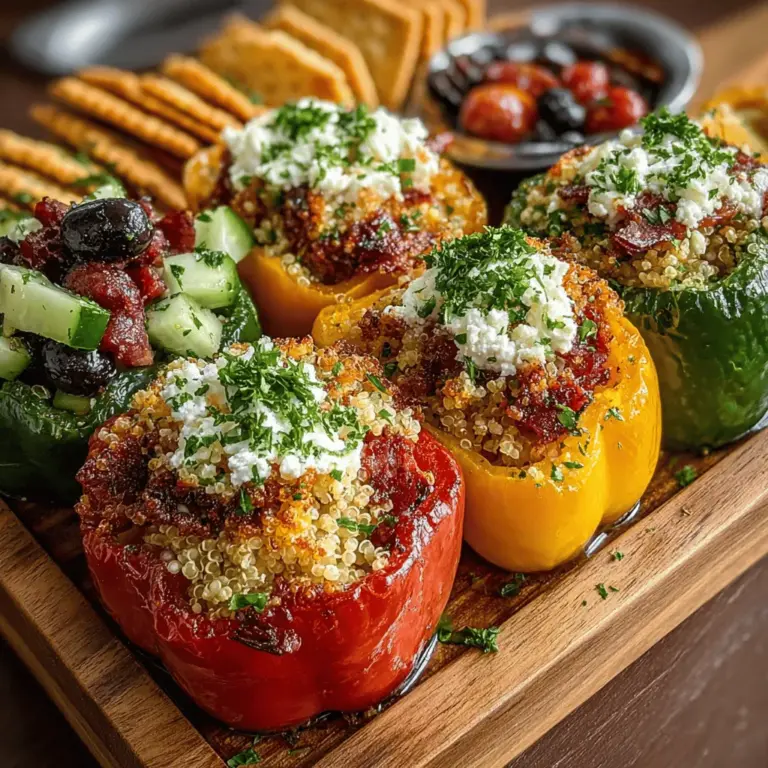Stuffed Charcuterie Board Bell Peppers Recipe
Introduction
In recent years, charcuterie boards have skyrocketed in popularity, transforming from traditional meat-and-cheese platters into a canvas for culinary creativity. These boards serve as an impressive centerpiece for gatherings, allowing hosts to curate an assortment of flavors, textures, and colors that cater to diverse palates. From artisanal cheeses to cured meats, olives, nuts, and fresh fruits, charcuterie boards offer a delightful experience that encourages social interaction and sharing.
However, as culinary trends evolve, innovative twists on classic recipes emerge. Enter the stuffed bell peppers — a creative and wholesome alternative to the traditional charcuterie board. By marrying the vibrant flavors of a charcuterie platter with the wholesome goodness of fresh vegetables, stuffed bell peppers present an enticing option for those looking to elevate their appetizer game. They not only look stunning on a platter but also pack a nutritional punch, making them a fantastic choice for health-conscious eaters.
Utilizing fresh ingredients in this recipe not only enhances the flavor but also contributes to numerous health benefits. Bell peppers, for instance, are rich in vitamins and antioxidants, while the other components of this dish, such as quinoa, meats, and fresh herbs, provide an excellent balance of nutrients. In this article, we will delve into the recipe for stuffed charcuterie board bell peppers, exploring their vibrant ingredients and guiding you through the initial steps of preparation.
Exploring the Ingredients
The foundation of any great dish lies in its ingredients. For our stuffed charcuterie board bell peppers, we will focus on several key components that contribute to both taste and nutritional value.
Bell Peppers:
Bell peppers are the stars of this recipe, providing not only a colorful presentation but also a plethora of health benefits. Available in shades of red, yellow, orange, and green, these peppers are loaded with vitamins A and C, potassium, and fiber. Their sweet and slightly tangy flavor pairs beautifully with a variety of fillings, making them perfect for stuffing. When selecting bell peppers, look for firm, glossy skin with no blemishes or soft spots, as these indicate freshness and quality.
Quinoa:
As a healthy grain alternative, quinoa introduces a nutty flavor and a delightful texture to our stuffing mixture. Known as a superfood, quinoa is packed with protein, fiber, and essential amino acids, making it an excellent choice for those seeking nutritious options. Unlike traditional grains, quinoa is gluten-free and provides a satisfying base for our filling while enhancing the overall health profile of the dish.
Meats:
Incorporating cured meats like salami and pepperoni elevates the flavor complexity of the stuffed bell peppers. Salami offers a rich, savory taste with a hint of spice, while pepperoni brings a smoky, slightly spicy kick. These meats not only add depth to the filling but also provide essential proteins and fats that contribute to the overall heartiness of the dish.
Cheeses:
A selection of cheeses plays a crucial role in enhancing the taste and texture of the stuffed peppers. Creamy cheeses like goat cheese or ricotta can provide a smooth contrast to the heartiness of the meats and quinoa, while sharper cheeses like cheddar or Parmesan add a delightful burst of flavor. The melting properties of cheese also help bind the filling together, ensuring a cohesive and satisfying bite.
Fresh Vegetables and Herbs:
To round out the stuffing, we’ll incorporate fresh vegetables and herbs. Ingredients such as diced tomatoes, spinach, or even olives can add brightness and freshness to the filling, while herbs like basil or parsley enhance the overall flavor profile. Fresh ingredients not only contribute essential nutrients but also ensure that each bite is bursting with flavor.
Preparation Process
Now that we have explored the vibrant ingredients that will come together to form our stuffed charcuterie board bell peppers, let’s dive into the preparation process. A well-executed preparation sets the stage for a delicious final dish.
Step 1: Preparing the Bell Peppers
Begin by preheating your oven to 375°F (190°C). While the oven warms up, it’s time to prepare the bell peppers. Start by rinsing each pepper under cool water to remove any dirt or residue. Once clean, slice the tops off the peppers and carefully remove the seeds and membranes. This step is crucial, as it creates a hollow space for our flavorful filling while ensuring that the peppers are easy to eat.
When choosing bell peppers for stuffing, opt for larger, firm varieties that can hold a generous amount of filling. Colorful options not only add visual appeal but can also offer subtle flavor variations, with red and yellow peppers being sweeter than their green counterparts.
Step 2: Creating the Filling
Next, we’ll prepare the filling for our stuffed peppers. Start by cooking the quinoa according to package instructions. Typically, this involves rinsing the quinoa under cold water, bringing water to a boil, adding the quinoa, and then simmering until the grains are fluffy and the water is absorbed. This process usually takes about 15 minutes. Perfectly cooked quinoa should be light, fluffy, and slightly chewy, providing a satisfying texture to the filling.
While the quinoa cooks, chop your selected meats, vegetables, and herbs. Sauté any fresh vegetables that require cooking, such as onions or spinach, in a skillet with a drizzle of olive oil until they are tender. This step not only enhances their flavor but also helps to reduce excess moisture, preventing the filling from becoming soggy.
Once the quinoa is cooked and the vegetables are sautéed, combine them in a large mixing bowl. Add in the chopped meats and cheeses, along with any fresh herbs you desire. To build a well-rounded flavor profile, don’t forget to season the mixture with salt, pepper, and any additional spices you enjoy, such as garlic powder or Italian seasoning.
Step 3: Balancing Flavors and Textures
As you mix the filling, it’s essential to strike a balance between flavors and textures. The combination of savory meats, creamy cheeses, and fresh vegetables should complement each other, creating a harmonious taste experience. Additionally, ensure that the filling is not overly dry or too moist. If it seems dry, consider adding a splash of broth or a drizzle of olive oil to help bring the ingredients together. If it’s too wet, adding a bit more quinoa can help absorb excess moisture.
With the filling prepared, it’s time to stuff the bell peppers. Carefully spoon the mixture into each hollowed pepper, pressing down gently to pack it in. Fill them generously without overflowing, as this will allow for even cooking and easier handling.
Step 4: Seasoning and Baking
To enhance the overall flavor profile, sprinkle a little extra cheese on top of each stuffed pepper. This creates a deliciously cheesy crust as they bake. Place the stuffed peppers upright in a baking dish and pour a small amount of broth or water at the bottom of the dish to help steam the peppers as they cook. Cover the dish with foil to retain moisture, and bake for approximately 25-30 minutes.
As they bake, the peppers will soften, while the filling becomes heated through and the flavors meld beautifully.
This innovative recipe for stuffed charcuterie board bell peppers is not just a feast for the eyes; it’s also a celebration of fresh, wholesome ingredients that nourish the body and delight the senses. By incorporating the delightful elements of a charcuterie board into a healthy, flavorful dish, you’re bound to impress your guests and enjoy a delicious meal that stands out in both taste and presentation. Stay tuned for the next part of the article, where we will explore the finishing touches and serving suggestions for these delectable stuffed peppers.

Baking the Stuffed Peppers
Now that your stuffed bell peppers are assembled, it’s time to bake them to perfection. Baking is a crucial step in this recipe, as it allows the flavors to meld beautifully and the textures to transform. Preheat your oven to 375°F (190°C) and prepare a baking dish by lightly greasing it with olive oil or cooking spray to prevent sticking.
Covering the Dish
Covering the dish with aluminum foil during the initial stage of baking is essential. This method traps steam inside the dish, ensuring that the peppers cook evenly and retain moisture. The foil acts as a protective barrier, allowing the filling to heat through without drying out the peppers. After about 20 minutes of covered baking, remove the foil to allow the tops to brown slightly, enhancing the flavor and texture.
Transforming Flavors and Textures
As your stuffed peppers bake, the heat works its magic. The bell peppers soften, becoming tender yet still holding their shape, while the filling becomes hot and slightly bubbly. The combination of flavors deepens, creating a harmonious blend that makes each bite delightful. Expect the cheese to melt into a creamy layer on top, adding richness to the dish.
Determining Doneness
To check for doneness, simply pierce a pepper with a fork. The pepper should be tender but not mushy. If you prefer a firmer texture, you can bake them for a shorter time. Typically, stuffed peppers take about 30-40 minutes to bake, depending on their size. Keep an eye on them as they bake; if the tops start to brown too quickly, you can re-cover them with foil.
Serving Suggestions
Once your stuffed bell peppers are out of the oven, it’s time to elevate their presentation and flavor pairings on your charcuterie board.
Enhancing Presentation
Place the baked stuffed bell peppers on a large serving platter or charcuterie board. You can garnish them with fresh herbs like parsley or basil to add a pop of color. Drizzle a bit of balsamic glaze over the peppers for an extra touch of sophistication. For a rustic touch, consider serving them on a wooden board alongside an array of colorful accompaniments.
Pairing with Crackers or Breadsticks
To complement the flavors of the stuffed peppers, offer an assortment of crackers or breadsticks. Their crunchy texture provides a delightful contrast to the tender peppers. Choose whole-grain or gluten-free options to cater to various dietary preferences. You can also include a selection of dips, such as hummus or tzatziki, to enhance the overall charcuterie experience.
Customizing for Dietary Preferences
One of the best aspects of stuffed bell peppers is their versatility. To cater to vegetarian diets, replace the meat with a mixture of quinoa, black beans, and sautéed vegetables. For a gluten-free version, ensure that any grains or sauces used are certified gluten-free. This dish can easily adapt to different dietary needs while remaining delicious and satisfying.
Culinary Variations
Exploring variations of stuffed bell peppers can make your culinary journey even more exciting. Here are some ways to customize the recipe to suit your tastes.
Substitutions for Meats and Cheeses
Feel free to experiment with different meats and cheeses to personalize your filling. Ground turkey, chicken, or pork can be excellent substitutes for beef. For a lighter option, consider using shredded rotisserie chicken. In terms of cheese, try feta or goat cheese for a tangy twist, or incorporate a blend of cheeses for added depth.
Incorporating Seasonal Vegetables
Adding seasonal vegetables not only boosts flavor but also increases the nutritional value of your dish. Consider mixing in chopped zucchini, spinach, or mushrooms to the filling for added freshness and color. These ingredients can enhance the overall taste while making the dish more wholesome.
Creating a Spicy Version
If you’re a fan of heat, consider making a spicy version of stuffed bell peppers. You can add finely chopped jalapeños or switch to spicier peppers like poblano or Anaheim. Adding crushed red pepper flakes or a dash of hot sauce to the filling will also elevate the spice level. Just be sure to adjust the quantities to your heat preference.
Health Benefits of Stuffed Bell Peppers
Stuffed bell peppers not only provide a burst of flavor but also come packed with health benefits. Let’s delve deeper into the nutritional analysis of the ingredients used in this dish.
Nutritional Analysis
Bell peppers are rich in vitamins A and C, antioxidants, and fiber, making them an excellent choice for a nutritious meal. The addition of whole grains, such as quinoa or brown rice, adds fiber and protein, promoting satiety. Lean meats or plant-based proteins contribute additional nutrients, ensuring a balanced meal.
Fitting into a Balanced Diet
Incorporating stuffed bell peppers into your diet aligns well with healthy eating patterns. This dish is low in calories while being high in nutrients, making it a fantastic option for those looking to maintain a healthy weight. Moreover, it encourages the consumption of more vegetables, which is essential for overall health.
Benefits of More Vegetables and Whole Grains
Increasing vegetable and whole grain intake has numerous health benefits, including improved digestion, enhanced heart health, and better blood sugar control. Stuffed bell peppers are an excellent vehicle for delivering these essential nutrients, making them a smart choice for meal prep or family dinners.
Conclusion
Preparing stuffed charcuterie board bell peppers is not just about cooking; it’s an opportunity to express your creativity in the kitchen. From selecting fresh ingredients to customizing the filling, each step allows you to explore new flavors and combinations. This dish is perfect for gatherings, meal prep, or a cozy family dinner, showcasing its versatility and appeal.
As you venture into making stuffed peppers, remember that experimentation is key. Feel free to mix and match ingredients, try different flavor profiles, and make this dish your own. Whether you stick to the classic recipe or venture into exciting variations, stuffed bell peppers are sure to delight your taste buds and impress your guests. So gather your ingredients, unleash your culinary creativity, and enjoy the delicious journey ahead!

